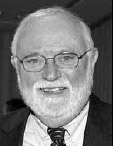
September 3, 2015
Quinnipiac University president Dr. John Lahey was educated as a philosopher, and landed in professional academia in the 1970s as a vice president at Marist College in Poughkeepsie, New York, with special skills in development and fund raising.
In 1987, he answered the call from Quinnipiac and relocated to Connecticut at age 40 to become one of the youngest college presidents in the country.
With a heritage from Clare, Cork, and Kerry, he was raised in the Bronx, and marched as a schoolboy down Fifth Avenue in the St Patrick’s Day parade. In 1996, he was named chief marshal of that parade.
In that role, he says, he was asked to speak before a wide array of Irish groups. It was the eve of the 150th anniversary of “Black 47,” the potato crop failure that led to the loss of millions of Irish lives, and he resolved to educate himself about “An Gorta Mór.” Reading the scholarly work of noted Irish historian Christine Kinealy, he developed a speech about that chapter in Ireland’s history. The experience, he says, led to a life-long interest in those tragic events.
Today, he proudly tells about the “Ireland’s Great Hunger Museum” he has established at Quinnipiac, and he talked with the BIR while promoting a special exhibition from the Quinnipiac collection that opens on Sept. 20.
Lahey credits Quinnipiac alumnus and board member Murray Lender, a principal of Lenders Bagels, for his guiding hand in establishing the Institute. “He’s a Polish Jew and had just sold the company for a couple of hundred million to Kraft Foods,” Lahey told me. “He was a great supporter of the Holocaust memorial, and he said to me, ‘Let’s create a room that focuses on the Great Hunger – I want a special room in the library.’ He had plenty of money, and he wanted to settle down and do something good.
“I told him I have big plans for the university, but I’m not going to get things done unless I get you on the board of directors. I need you for your leadership and financial support. By the time this Great Hunger thing came around he was already vice chairman of the board.”
The school’s collection – now more than 100 pieces of art – soon outgrew the on-campus library, so with Lender’s full support, the school bought and completely renovated a property on the edge of the Hamden campus, near the border with New Haven.
“Yale is right down the street from us,” he said, “less than ten miles away. Whitney Avenue goes north and south, from Hamden right down to the town, right to Yale. At Yale they have the Mellon Museum of British art, a pretty good collection that Mellon gave them. And up the street on the same Whitney Avenue we have Ireland’s Great Hunger Museum.
“I think it symbolizes the two institutions. They (Yale) have been around a long time, the blue bloods. And we’re the scrappy Irish who had to fight all the way. It’s a great thing!”
Key to Lahey’s plans was recruiting Kinealy from Drew University in New Jersey: “For three years I recruited her,” he said. “I had my eyes on her, I had to get her. I told her I’ll get you tenured professor, and I would create a Great Hunger Institute. We’ll give you research support, with conferences, publications and so on. You’ll be the academic portion.”
The pitch worked, and Kinealy accepted the professorship in 2013. “She’s the foremost authority on both sides of the Atlantic,” he said. “I believe there will be more research and educational activity in connection with Ireland’s Great Hunger at Quinnipiac than anywhere else in the world. We just started an Irish Studies program in conjunction with Maynooth. That program will develop into a full major probably in the next couple of years.
“The Great Hunger is a story that not only has not been told, but also in some ways it has been mis-told,” Lahey said. “That’s why we use the word ‘Hunger.’ In the eyes of many people ‘Famine’ means there wasn’t any food – when in fact there was.”

